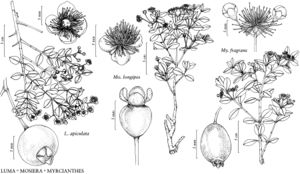Mosiera
Man. S.E. Fl., 936, 1506, fig. [p. 937]. 1933.
| Taxon | Illustrator ⠉ | |
|---|---|---|
 | Luma apiculata Mosiera longipes Myrcianthes fragrans |
Shrubs or trees, glabrous or pubescent, hairs simple. Leaves usually subopposite or whorled, sometimes decussate; blade venation brochidodromous [hyphodromous]. Inflorescences 1-flowered or 3 (–5) -flowered, axillary, often solitary flowers, sometimes dichasia or racemes with 1–3 (–5) decussate pairs of flowers. Flowers 4-merous, sessile or pedicellate; hypanthium obconic to campanulate; calyx lobes distinct in bud, usually erect in fruit; petals white; stamens [30–] 76–120 [–250]; connective usually with 1 terminal oil-gland; ovary [1 or] 2–4-locular; placentation axile [to parietal], placenta not prominent; ovules [3–] 9–40 per locule. Fruits berries, dark purple, red, or black, ellipsoid to globose. Seeds 2–27, subreniform; seed-coat smooth or leathery, surface cells isodiametric and not overlapping; embryo whitish, -shaped, oily; cotyledons linear, reflexed, less than 1/4 length of embryo; hypocotyl as wide as or wider than cotyledons.
Distribution
Florida, Mexico, West Indies, Central America (Guatemala)
Discussion
Species ca. 20 (1 in the flora).
Selected References
None.